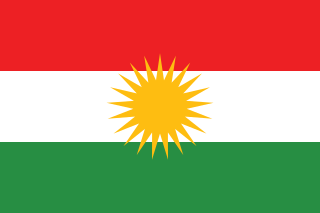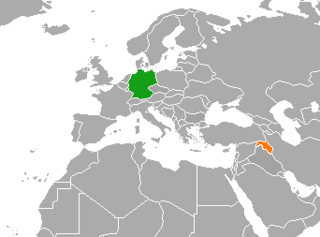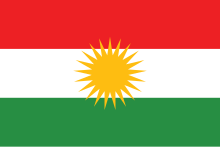
Kurdistan Region is a semi-autonomous administrative entity within the Republic of Iraq. It comprises four Kurdish-majority divisions of Arab-majority Iraq: the Erbil Governorate, the Sulaymaniyah Governorate, the Duhok Governorate, and Halabja Governorate. The KRI is bordered by Iran to the east, by Turkey to the north, and by Syria to the west. It does not govern all of Iraqi Kurdistan, and lays claim to the disputed territories of northern Iraq; these territories have a predominantly non-Arab population and were subject to the Ba'athist Arabization campaigns throughout the late 20th century. Though the KRI's autonomy was realized in 1992, one year after Iraq's defeat in the Gulf War, these northern territories remain contested between the Kurdistan Regional Government and the Government of Iraq to the present day. In light of the dispute, the KRI's constitution declares the city of Kirkuk as the capital of Iraqi Kurdistan. However, the KRI does not control Kirkuk, and the Kurdistan Region Parliament is based in Erbil. In 2014, when the Syria-based Islamic State began their Northern Iraq offensive and invaded the country, the Iraqi Armed Forces retreated from most of the disputed territories. The KRI's Peshmerga then entered and took control of them for the duration of the War in Iraq (2013–2017). In October 2017, following the defeat of the Islamic State, the Iraqi Armed Forces attacked the Peshmerga and reasserted control over the disputed territories.

Masoud Barzani is a Kurdish politician who has been leader of the Kurdistan Democratic Party (KDP) since 1979, and was President of the Kurdistan Region of Iraq from 2005 to 2017.

Masrour Barzani is a Kurdish politician and serving as prime minister of the Kurdistan Region, an autonomous region in Iraq, since June 2019. He is also the chancellor of the Kurdistan Region Security Council and a member of the Kurdistan Democratic Party. He was sworn in as prime minister of the KRG’s ninth cabinet on 10 June 2019, after receiving 87 votes out of 97 legislators in the Kurdistan parliament.

Kosrat Rasul Ali is a Kurdish politician and the leader of the Supreme Political Council of Patriotic Union of Kurdistan (PUK), veteran Peshmerga military leader, former Prime Minister, and former Vice President of the Kurdistan Region.

The Kurdistan Democratic Party, usually abbreviated as KDP or PDK, is the ruling party in Iraqi Kurdistan and the senior partner in the Kurdistan Regional Government. It was founded in 1946 in Mahabad in Iranian Kurdistan. The party states that it combines "democratic values and social justice to form a system whereby everyone in Kurdistan can live on an equal basis with great emphasis given to rights of individuals and freedom of expression."

Nawshirwan Mustafa was an Iraqi Kurdish politician who served as the General Coordinator of the Movement for Change and the leader of the opposition in the Kurdistan Region from 1 April 2009 to his death on 19 May 2017.

The 1983–1986 Kurdish rebellions in Iraq occurred during the Iran–Iraq War as PUK and KDP Kurdish militias of Iraqi Kurdistan rebelled against Saddam Hussein as part of the Iraqi–Kurdish conflict, in an attempt to form an independent state. With Iraqi government forces occupied by the Iran-Iraq War, Kurdish Peshmerga succeeded in taking control of some enclaves, with Iranian logistic and sometimes military support. The initial rebellion resulted in stalemate by 1985.

The Iraqi–Kurdish conflict consists of a series of wars, rebellions and disputes between the Kurds and the central authority of Iraq starting in the 20th century shortly after the defeat of the Ottoman Empire in World War I. Some put the marking point of the conflict beginning to the attempt by Mahmud Barzanji to establish an independent Kingdom of Kurdistan, while others relate to the conflict as only the post-1961 insurrection by the Barzanis.

The disputed territories of northern Iraq are regions defined by article 140 of the Constitution of Iraq as being Arabised during Baath Party rule in Iraq. Most of these regions are inhabited by non-Arabs, including Kurds, Assyrians, Yazidis, Turkmens/Turkomans, and Shabaks.

An independence referendum for the Kurdistan Region of Iraq was held on 25 September 2017, with preliminary results showing approximately 92.73 percent of votes cast in favour of independence. Despite reporting that the independence referendum would be non-binding, the autonomous Kurdistan Regional Government (KRG) characterised it as binding, although they claimed that an affirmative result would trigger the start of state building and negotiations with Iraq rather than an immediate declaration of independence of Kurdistan. The referendum's legality was rejected by the federal government of Iraq and the Federal Supreme Court.
The Peshmerga have historically been Kurdish guerrilla forces combating the ruling power in the region of what is now Iraqi Kurdistan. Under Mahmud Barzanji, the Peshmerga fought against the British Empire after World War I. They also spearheaded revolts against the Iraqi government in 1931–1932 and against Iran in 1946–1947. Under the leadership of Mustafa Barzani, Peshmerga forces fought the Iraqi government in the First and Second Iraqi–Kurdish Wars of the 1960s and 1970s, and supported Iran in the Iran–Iraq War of the 1980s. The Peshmerga became divided between forces loyal to the Kurdistan Democratic Party (KDP) and those loyal to the Patriotic Union of Kurdistan (PUK), a split that led to the Iraqi Kurdish Civil War of 1995–1998. After the 2003 invasion of Iraq, the Peshmerga became the official military forces of the Kurdistan Region, ruled by a KDP-PUK coalition. The Peshmerga have played an important role in re-taking territory occupied by Islamic State of Iraq and the Levant.

The Protection Force of Êzîdxan (HPÊ), is a Yazidi military force founded by Haydar Shesho in the summer of 2014 in respond to the Sinjar massacre. It was bigger than the other main Yazidi militia who took part in the liberation of Sinjar from Islamic State, the Sinjar Resistance Units, which is aligned with the PKK-backed Kurdistan Communities Union.

The November Sinjar offensive was a combination of operations of Kurdish Peshmerga, PKK, and Yezidi Kurd militias in November 2015, to recapture the city of Sinjar from the Islamic State of Iraq and the Levant. It resulted in a decisive victory for the Kurdish forces, who expelled the ISIL militants from Sinjar and regained control of Highway 47, which until then had served as the major supply route between the ISIL strongholds of Raqqa and Mosul.

Parliamentary elections took place in Kurdistan Region on 30 September 2018 to elect Parliament. The election came a year after a failed bid for independence and left the ruling Kurdistan Democratic Party (KDP) with 45 seats, that positioning it to lead the next regional government. Announcement of the results was delayed for three weeks. The KDP's historic rival and junior coalition partner in government, the Patriotic Union of Kurdistan (PUK), was in second place with 21 seats. The results suggest that Masoud Barzani’s KDP will take a dominant position in Kurdish politics.
Sirwan Saber Barzani is an Iraqi Kurdish businessman and military commander. He is a member of the Kurdish Barzani family. He is the older brother of Saywan Barzani, a Kurdish diplomat.

Germany–Kurdistan Region relations are bilateral relations between Germany and Kurdistan Region. Germany has a consulate general in Erbil since 2012, and Kurdistan Region has a representation in Berlin since 1992. Many high-level meetings have been held between the two parties, including a visit to Berlin by Kurdish President Masoud Barzani in 2009, where he met with German Chancellor Angela Merkel and Foreign Minister Frank-Walter Steinmeier. In 2014, President Barzani described Germany as "one of Kurdistan Region’s staunch allies in the war against the Islamic State." German Consul General Marc Eichhorn described the relations as "excellent".

The 2017 Iraqi–Kurdish conflict, also known as the Kirkuk crisis, was a conflict in which the Iraqi government retook disputed territories in Iraq which had been held by the Peshmerga since ISIL's Northern Iraq offensive in 2014. The conflict began on 15 October 2017 after tensions arising from the Kurdistan Region independence referendum of 25 September. The tension between the federal Iraqi government and Kurdistan Region escalated into conflict when the Peshmerga ignored repeated warnings to return Kirkuk to Iraqi government forces. Part of the conflict was the Battle of Kirkuk, when Iraqi forces routed Peshmerga forces from the city in a surprise dawn-offensive, marking the beginning of clashes.

Hemin Hawrami, ,, is a Kurdish politician, writer and academic. He has been the Deputy Speaker of the Iraqi Kurdistan Parliament since February 2019. He is a senior member of the Kurdistan Democratic Party. He was elected as a Member of the Kurdistan Parliament in September 2018. He was the head of the Kurdistan Democratic Party's foreign relations (2011–2017) and later a senior adviser to President Masoud Barzani (2017–2019) for political and international affairs. He holds a PhD in international relations and he has written eight books in Kurdish on Kurdish politics.
The Kurdistan Region–PKK conflict is a series of battles and clashes in Iraqi Kurdistan between the ruling Kurdistan Regional Government against the Kurdistan Workers' Party (PKK) and its allied groups. It started in 1983 and is still ongoing in the form of an insurgency. The PKK's primary method is using guerrilla warfare against the Peshmerga.

The Peshmerga Roj, also known as Rojava Peshmerga, are the military wing of the Kurdish National Council and KRG in Syria. They are pro-KDP and take orders from President Barzani of Iraqi Kurdistan.




















